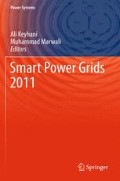Abstract
Integration of different types of distributed energy resources (DERs) in distribution network has significant effects on voltage profile for both customers and distribution network service providers (DNSPs). This impact may manifest itself positively or negatively, depending on the voltage variation and the amount of DERs that can be connected to the distribution networks. This chapter presents a way to estimate the voltage variation and the amount of the DERs in a microgrid. To do this, a voltage rise formula is derived with some approximation and the validation of this formula is checked by comparing with the existing power |systems simulation software. Using the voltage variation formula, the worst case scenario of microgrid is used to estimate the amount of voltage variation and maximum permissible DERs. The relationship between voltage level, voltage rise, and connection cost of DERs in a microgrid is also described in this chapter. Finally, based on the worst case scenario of microgrid; some recommendations are given to counteract the voltage rise effect.
An Erratum for this chapter can be found at http://dx.doi.org/10.1007/978-3-642-21578-0_22
An erratum to this chapter can be found at http://dx.doi.org/10.1007/978-3-642-21578-0_22
Access this chapter
Tax calculation will be finalised at checkout
Purchases are for personal use only
Preview
Unable to display preview. Download preview PDF.
References
Alderfer, B., Eldridge, M., Starrs, T.: Making connection: Case studies of interconnection barriers and their impact on distributed power projects. National Renewable Energy Laboratory (2000)
Willis, H.L., Scott, W.G.: Distributed Power Generation: Planning and Evaluation. Marcel Dekker, New York (2000)
Wright, A.J., Formby, J.R.: Overcoming barriers to scheduling embedded generation to support distribution networks. EA Technology- Department of Trade and Industry (2000)
Akorede, M.F., Hizam, H., Pouresmaeil, E.: Distributed energy resources and benefits to the environment. Renewable and Sustainable Energy Reviews 14(10), 724–734 (2010)
Chiradeja, P., Ramakumar, R.: An approach to quantify the technical benefits of distributed generation. IEEE Trans. on Energy Conversion 19(4), 764–773 (2004)
Ochoa, L.F., Padilha-Feltrin, A., Harrison, G.P.: Evaluating distributed generation impacts with a multiobjective index. IEEE Trans. on Power Delivery 21(3), 1452–1458 (2006)
Masters, C.L.: Voltage rise: the big issue when connecting embedded generation to long 11 kV overhead lines. IET Power Engineering Journal 16(2), 5–12 (2002)
Ochoa, L.F.: Time-series based maximization of distributed wind power generation integration. IEEE Trans. on Energy Conversion 23(3), 968–974 (2008)
Quezada, V.H.M., Abbad, J.R., Romn, T.G.S.: Assessment of energy distribution losses for increasing penetration of distributed generation. IEEE Trans. on Power Systems 21(2), 533–540 (2006)
Wang, C., Nehrir, M.H.: Analytical approaches for optimal placement of distributed generation sources in power systems. IEEE Trans. on Power Systems 19(4), 2068–2076 (2004)
Acharya, N., Mahat, P., Mithulananthan, N.: An analytical approach for dg allocation in primary distribution network. Int. J. Elect. Power and Energy Syst. 28(10), 669–678 (2006)
Dent, C.J., Ochoa, L.F., Harrison, G.P.: Network distribution capacity analysis using OPF with voltage step constraints. IEEE Trans. on Power Systems 25(1), 296–304 (2010)
Ochoa, L.F., Dent, C.J., Harrison, G.P.: Distribution network capacity assessment: Variable DG and active networks. IEEE Trans. on Power Systems 25(1), 87–95 (2010)
Keane, A., Ochoa, L.F., Vittal, E., Dent, C.J., Harrison, G.P.: Enhanced utilization of voltage control resources with distributed generation. IEEE Trans. on Power Systems 26(1), 252–260 (2011)
Kersting, W.H.: Distribution System Modelling and Analysis, 2nd edn. CRC Press, London (2007)
IEEE 34 node test feeder. IEEE PES Distribution System Analysis Subcommittee, http://www.ewh.ieee.org/soc/pes/dsacom/testfeeders/index.html (accessed November 28, 2010)
Strbac, G., Jenkins, N., Hird, M., et al.: Integration of operation of embedded generation and distribution networks. Manchester Centre for Electrical Energy (2002)
Mutale, J.: Benefits of active management of distribution networks with distributed generation. In: Power Systems Conference and Exposition PSCE, pp. 601–606 (2006)
Energy Australia Report, Network Pricing List (2010), http://www.energyaustralia.com.au/Common/Network-Supply-and-Services/Electricity-supply/~/media/Files/Network/Electricity%20Supply/Network%20Pricing/20100621NetworkPricelist201011.ashx (accessed March 22, 2011)
Author information
Authors and Affiliations
Corresponding author
Editor information
Editors and Affiliations
Rights and permissions
Copyright information
© 2012 Springer-Verlag Berlin Heidelberg
About this chapter
Cite this chapter
Mahmud, M.A., Hossain, M.J., Pota, H.R. (2012). Worst Case Voltage Variation on Microgrid. In: Keyhani, A., Marwali, M. (eds) Smart Power Grids 2011. Power Systems. Springer, Berlin, Heidelberg. https://doi.org/10.1007/978-3-642-21578-0_10
Download citation
DOI: https://doi.org/10.1007/978-3-642-21578-0_10
Publisher Name: Springer, Berlin, Heidelberg
Print ISBN: 978-3-642-21577-3
Online ISBN: 978-3-642-21578-0
eBook Packages: EngineeringEngineering (R0)

